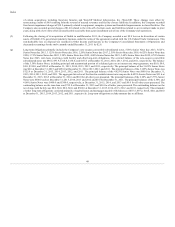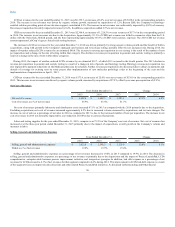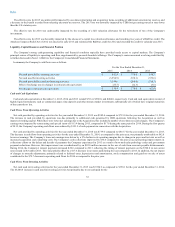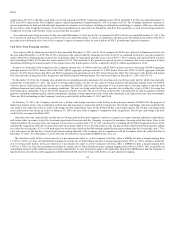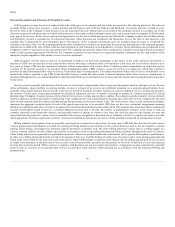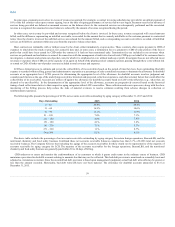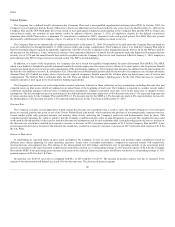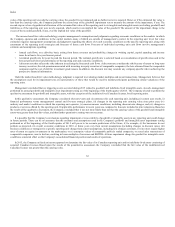LabCorp 2015 Annual Report Download - page 56
Download and view the complete annual report
Please find page 56 of the 2015 LabCorp annual report below. You can navigate through the pages in the report by either clicking on the pages listed below, or by using the keyword search tool below to find specific information within the annual report.
Index
(a) Contingent future licensing payments will be made if certain events take place, such as the launch of a specific test, the transfer of certain technology,
and when specified revenue milestones are met.
(b) The table does not include obligations under the Company’s pension and postretirement benefit plans, which are included in “Note 16 to Consolidated
Financial Statements.” Benefits under the Company's postretirement medical plan are made when claims are submitted for payment, the timing of which
is not practicable to estimate.
(c) The table does not include the Company’s reserves for unrecognized tax benefits. The Company had a $36.9 and $24.9 reserve for unrecognized tax
benefits, including interest and penalties, at December 31, 2015 and 2014, respectively, which is included in “Note 13 to Consolidated Financial
Statements.” Substantially all of these tax reserves are classified in other long-term liabilities in the Company’s Consolidated Balance Sheets at
December 31, 2015 and 2014.
The Company does not have transactions or relationships with “special purpose” entities, and the Company does not have any off-balance sheet
financing other than normal operating leases and letters of credits.
As of December 31, 2015, the Company provided letters of credit aggregating approximately $45.4, primarily in connection with certain insurance
programs. Letters of credit provided by the Company are secured by the new Company’s Revolving Credit Facility and are renewed annually, around mid-
year.
The contractual value of the noncontrolling interest put in the Company's Ontario subsidiary totaled $14.9 and $17.7 at December 31, 2015 and 2014,
respectively, which have been classified as mezzanine equity in the Company's consolidated balance sheet.
Based on current and projected levels of operations, coupled with availability under its Revolving Credit Facility, the Company believes it has sufficient
liquidity to meet both its anticipated short-term and long-term cash needs; however, the Company continually reassesses its liquidity position in light of
market conditions and other relevant factors.
In April 2014, the FASB issued a new accounting standard on discontinued operations that significantly changed criteria for discontinued operations and
disclosures for disposals. Under this new standard, to be a discontinued operation, a component or group of components must represent a strategic shift that
has (or will have) a major effect on an entity's operations and financial results. Expanded disclosures for discontinued operations include more details about
earnings and balance sheet accounts, total operating and investing cash flows, and cash flows resulting from continuing involvement. The Company has
adopted the guidance of this new standard effective beginning in 2015 and will apply it prospectively to all new disposals of components and new
classifications as held for sale. The adoption of this standard did not have a material impact on the consolidated financial statements.
In May 2014, the FASB issued the converged standard on revenue recognition with the objective of providing a single, comprehensive model for all
contracts with customers to improve comparability in the financial statements of companies reporting using International Financial Reporting Standards and
U.S. Generally Accepted Accounting Principles. The standard contains principles that an entity must apply to determine the measurement of revenue and
timing of when it is recognized. The underlying principle is that an entity must recognize revenue to depict the transfer of goods or services to customers at
an amount that the entity expects to be entitled to in exchange for those goods or services. An entity can apply the revenue standard retrospectively to each
prior reporting period presented (full retrospective method) or retrospectively with the cumulative effect of initially applying the standard recognized at the
date of initial application in retained earnings. As originally issued, the new revenue recognition standard would be effective for the Company beginning
January 1, 2017. On July 9, 2015, the FASB approved the proposal to defer the effective date of this standard by one year. The standard will be effective for
the Company beginning January 1, 2018, with early adoption permitted for annual periods beginning after December 16, 2016. The Company is currently
evaluating the expected impact of the standard.
In August 2014, the FASB issued a new accounting standard that explicitly requires management to assess an entity's ability to continue as a going
concern, and to provide related financial statement footnote disclosures in certain circumstances. Under this standard, in connection with each annual and
interim period, management must assess whether there is substantial doubt about an entity's ability to continue as a going concern within one year after the
financial statements are issued (or available to be issued when applicable). Management shall consider relevant conditions and events that are known and
reasonably knowable at such issuance date. Substantial doubt about an entity's ability to continue as a going concern exists if it is probable that the entity
will
56




